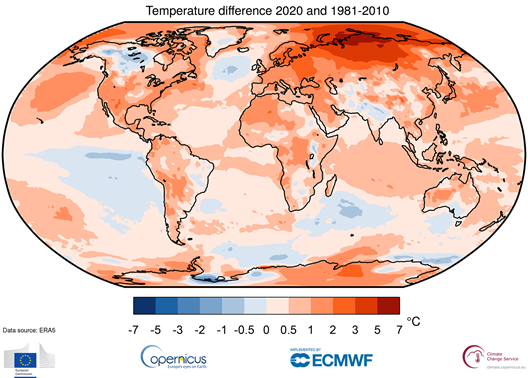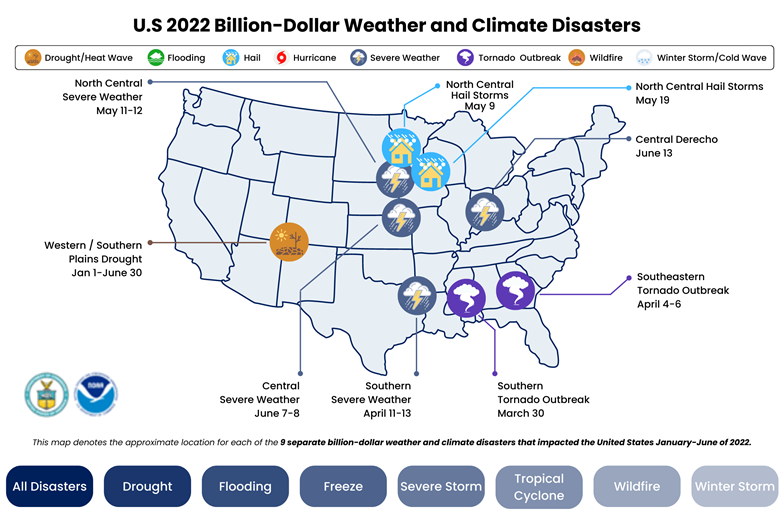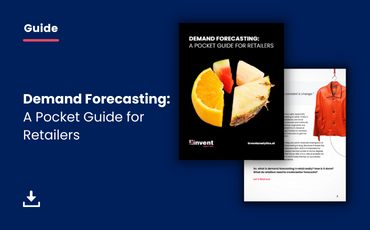
How Weather Data Improves Retail Demand Forecasting
Supply chain leaders know one thing is clear: demand forecasting has never been more critical, and they need truly comprehensive inventory planning tools to get it right.
One of the biggest challenges that retail executives face today is forecasting demand. Unfortunately, this is a challenge that is getting tougher day by day. Supply chain planning teams aim to achieve and maintain an effectively lean supply chain where they can store the necessary inventory on hand to meet the forecasted demand and reduce overhead and inventory carrying costs.
Finding the right balance can be tricky.
Retailers work hard to better understand the demand drivers to have the right products at the right time and delight their customers with perfect shopping experiences. But many factors make demand challenging to predict and uncertain. And the weather is probably one of the most influential variables in demand forecasting.
Weather is a powerful driver of demand
Weather is a powerful driver of demand that constantly changes, and it can impact retailers in a various ways.
When temperatures spike or drop, your consumers will change their shopping habits. Weather influences their emotional states, drives their purchasing decisions, and dictates how much they are willing to spend. Think about it: the food we eat and the clothes we wear can all be determined by the fluctuations in weather.
Second, weather impacts different product categories differently. For example, when it rains, people want umbrellas; when it's hot, they want cold drinks to keep them cool; and when it snows, they want warm clothing.
Weather even affects how we choose to shop. If it is raining, we tend to shop online or spend more time at a shopping mall. On the other hand, if it’s sunny, we are more likely to venture out and visit standalone stores, or open-air shopping centers, like a strip mall.
Weather affects your sales
Rain or shine, weather can make a big difference in your sales performance. There is no doubt that your forecasting and inventory planning teams need to have the tools and processes in place to predict and prepare for the weather’s impact.
If the weather catches you by surprise, then you need to deal with either excess inventory or not having enough inventory to meet the demand.
We also know that as much as you may be prepared to take on the next quarter, not everything will go as planned. For example, a surprising hot or cold weather forecast could ruin your inventory forecasts and planning. But still, retailers need to minimize the risks and use weather data in their forecasting. This will draw the line between increased sales and happy customers or lost sales and unsatisfied customers.
As the importance of changes in weather grows, understanding weather is crucial for retailers who want to improve their demand forecasting.
Here are 3 key things you need to know when it comes to using weather data and improving your forecast accuracy.
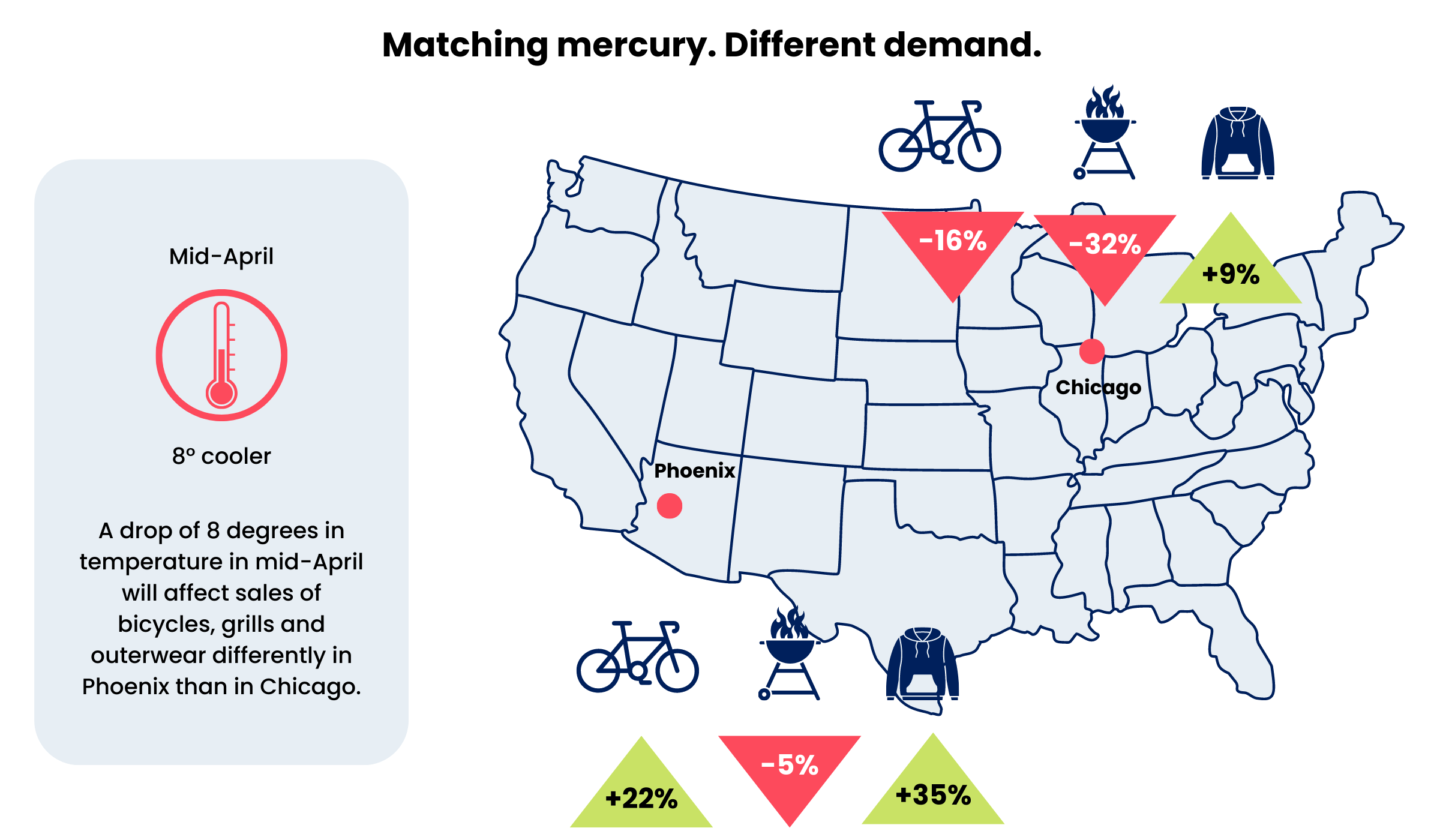
1. Global warming is impacting forecasting
It’s no secret that the retail industry is vulnerable to the consequences of climate change. The risk of global warming puts the industry under pressure in many ways. Especially in the last 10 years, retailers had to deal with irregular weather changes that impacted their merchandising calendar for seasonal items. In addition, traditional forecasting systems that take weather for granted have become increasingly inaccurate with these abnormal weather events.
For apparel retailers, unpredictable weather has become a major factor in creating uncertainty. Historical demand forecasting and sales plans started becoming more outdated, leaving retailers not with a good reference for the future.
Source: ERA5. Credit: Copernicus Climate Change Service/ECMWF
2. Changing temperature is changing demand
Weather is a notoriously fickle and uncontrollable factor, and no retail forecasting or planning team member can perfectly predict the temperature beyond the next few weeks. We also know it’s no longer effective to make nominal weather forecasts and make temperature predictions on any given day because there will most likely be some fluctuations and the forecast will probably be wrong. Instead of making such predictions, retailers can use the weather data in buckets, come up with a range (for example, 85-95 degrees) and use this data in their machine learning algorithms to enhance their forecasts.
To make inventory planning with greater certainty, retailers need to leverage predictive analytics and machine learning to the fullest, along with what-if scenario planning. They need a solution that integrates weather data into the process, helping them pivot quickly.
3. Natural disasters: Predicting demand in an unpredictable world
Over the last 40 years, according to the National Centers for Environmental Information, the United States alone has sustained 332 weather and climate events where the cumulative costs reached $2.275 trillion
Natural disasters can disrupt supply chain planning over long periods of time. Retailers experiencing these destructive events can be greatly impacted by them. With global warming, risks from national disasters such as floods, hurricanes or wildfires are increasing, and retailers are more likely to face operational disruptions in the future.
These extreme weather events put retailers at more risk as a number of storefront operations can be impacted by floods or hurricanes; therefore, they need to be prepared more than ever.
Are you prepared to react?
In 2023, retailers need to adopt new operational strategies to increase their agility and flexibility. They need the tools and systems to respond to weather changes.
Today’s forecasts should use historical data for the previous years’ sales, promotional data, channels of distribution, external data relevant to their retail vertical, and information on general economic and local circumstances. More importantly, weather changes should be incorporated into forecasting models to generate more accurate forecasts.

How Invent Analytics can help
The days of simply creating a “set it and forget it” mentality for retail demand forecasting algorithms are gone. Today’s changing times require adaptation and continuous improvement.
At Invent Analytics, we translate these forecasting adjustments to help retailers achieve better business outcomes. We use a combination of quality data, machine learning, and advanced analytics to generate better forecasts.
We know that forecasting for the near future, capturing the impacts of local weather and using the short-term demand forecasts for store replenishment can make a big difference for retailers.
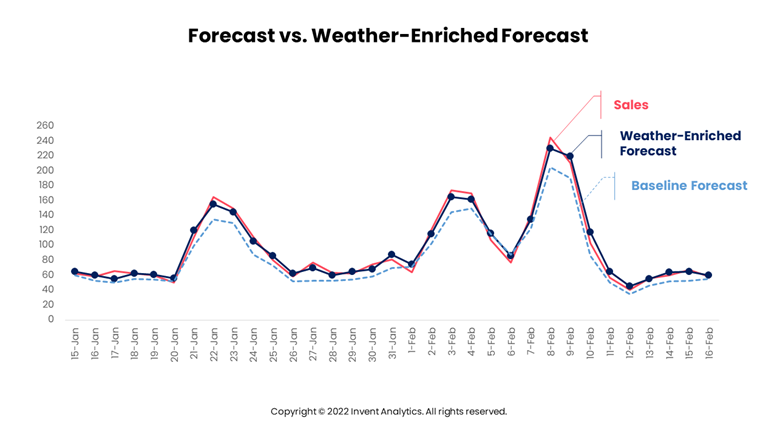
Invent Analytics’ Demand Forecasting solution uses over 300 forecasting features at the store-SKU level that are correlated with the weather-effect features. It blends various features to generate actionable and more accurate forecasts.
These features take into account
- Store location (shopping mall or street store)
- Day of the week (weekday or weekend)
- Whether or not there is a discount period
- The previous day's weather
- The temperature of the previous day
- Historical temperature data
Ready to take action?
Executing a successful demand forecasting strategy is critical for better planning, but it is also highly challenging. Retailers can no longer afford to manage their inventory planning operations in silos with traditional planning systems.
To succeed, retailers need to leverage modern inventory planning systems. And every successful inventory planning must start with AI-powered demand forecasting. To find out how we can help you incorporate weather data into your forecasting more effectively and help you become more resilient to these external factors, speak to one of our retail experts today.
